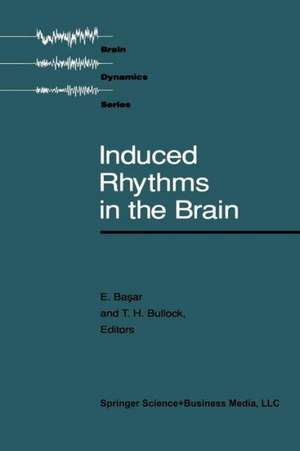Induced Rhythms in the Brain: Brain Dynamics
Autor Basar, Bullocken Limba Engleză Paperback – 6 sep 2012
Preț: 380.10 lei
Preț vechi: 400.10 lei
-5% Nou
Puncte Express: 570
Preț estimativ în valută:
72.76€ • 79.05$ • 61.15£
72.76€ • 79.05$ • 61.15£
Carte tipărită la comandă
Livrare economică 21 aprilie-05 mai
Preluare comenzi: 021 569.72.76
Specificații
ISBN-13: 9781475712834
ISBN-10: 1475712839
Pagini: 504
Ilustrații: XIX, 483 p. 83 illus., 11 illus. in color.
Dimensiuni: 155 x 235 x 26 mm
Greutate: 0.7 kg
Ediția:Softcover reprint of the original 1st ed. 1992
Editura: Birkhäuser Boston
Colecția Birkhäuser
Seria Brain Dynamics
Locul publicării:Boston, MA, United States
ISBN-10: 1475712839
Pagini: 504
Ilustrații: XIX, 483 p. 83 illus., 11 illus. in color.
Dimensiuni: 155 x 235 x 26 mm
Greutate: 0.7 kg
Ediția:Softcover reprint of the original 1st ed. 1992
Editura: Birkhäuser Boston
Colecția Birkhäuser
Seria Brain Dynamics
Locul publicării:Boston, MA, United States
Public țintă
ResearchCuprins
to Induced Rhythms: A Widespread, Heterogeneous Class of Oscillations.- Oscillations in the Striate Cortex.- 1 Mechanisms Underlying the Generation of Neuronal Oscillations in Cat Visual Cortex.- 2 Stimulus-Specific Synchronizations in Cat Visual Cortex: Multiple Microelectrode and Correlation Studies from Several Cortical Areas.- Cortical Rhythms, Ongoing (EEG) and Induced (ERPs).- 3 The Rhythmic Slow Activity (Theta) of the Limbic Cortex: An Oscillation in Search of a Function.- 4 Is There any Message Hidden in the Human EEG?.- 5 Event-Related Synchronization and Desynchronization of Alpha and Beta Waves in a Cognitive Task.- 6 Magnetoencephalographic Evidence for Induced Rhythms.- 7 Rostrocaudal Scan in Human Brain: A Global Characteristic of the 40-Hz Response During Sensory Input.- 8 Evoked Potentials: Ensembles of Brain Induced Rhythmicities in the Alpha, Theta and Gamma Ranges.- 9 Predictions on Neocortical Dynamics Derived from Studies in Paleocortex.- 10 A Comparison of Certain Gamma Band (40-HZ) Brain Rhythms in Cat and Man.- 11 Human Visual Evoked Potentials: Induced Rhythms or Separable Components?.- Thalamic Oscillations.- 12 Network Properties of the Thalamic Clock: Role of Oscillatory Behavior in Mood Disorders.- 13 Mesopontine Cholinergic Systems Suppress Slow Rhythms and Induce Fast Oscillations in Thalamocortical Circuits.- 14 Oscillations in CNS Neurons: A Possible Role for Cortical Interneurons in the Generation of 40-Hz Oscillations.- Cellular and Subcellular Mechanisms Based on Invertebrate and Simple Systems.- 15 Modification of Oscillator Function by Electrical Coupling to Nonoscillatory Neurons.- 16 Biological Timing: Circadian Oscillations, Cell Division, and Pulsatile Secretion.- 17 Comparison of Electrical Oscillations in Neurons with Inducedor Spontaneous Cellular Rhythms due to Biochemical Regulation.- 18 Signal Functions of Brain Electrical Rhythms and their Modulation by External Electromagnetic Fields.- Theories and Models.- 19 Inhibitory Interneurons can Rapidly Phase-Lock Neural Populations.- 20 The Problem of Neural Integration: Induced Rhythms and Short-Term Correlations.- 21 Flexible Linking of Visual Features by Stimulus-Related Synchronizations of Model Neurons.- 22 Synergetics of the Brain: An Outline of Some Basic Ideas.- Epilogue.- Brain Natural Frequencies are Causal Factors for Resonances and Induced Rhythms.














